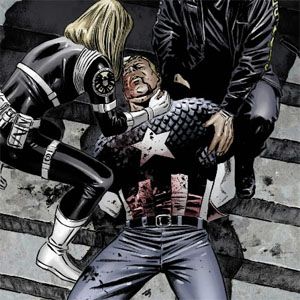I've always, at heart, felt myself to be a Star Wars fan (especially in light of the classic “Wars vs. Trek” question.) In fact, I watched one or two episodes of Star Trek and didn't get it at first, so I was convinced that I didn't like it, I didn't keep up with it or make an effort to watch any of the other shows. It took a very specific set of circumstances to make me a fan of Star Trek, and prominently involved is the Trek-specific technology I want to talk a little bit about today. One day, flipping channels looking for anything remotely interesting, I saw a specific image that made me stop.
 |
| The character that tricked me into becoming a Trekkie. |
I've always liked film noir stories involving hard-boiled private eyes, dangerous women and a dirty mystery in a desperate city, bonus points if the setting is in the 1920s or 1930s. I got into the story in progress about the gumshoe Dixon Hill, a tough but obviously very intelligent private detective. It didn't take too long for Dixon to suddenly say in a very different, very British voice “Computer, halt simulation,” and everything froze. A portion of the wall opened up on a futuristic corridor, and it was apparent that Dixon Hill was on a starship. Moments later, it was clear that he was the captain, and the ship was the USS Enterprise. My mind was blown. I was watching Star Trek, and enjoying it.
Though I became a fan of Star Trek: The Next Generation in general, and eventually watched every episode, I never forgot about Dixon Hill or the holodeck, and episodes featuring one or both remain my favorites to this day. Teleportation, warp drive technology, replication and phasers are all amazing, but none captured my imagination quite like the holodeck. In a way, it really is the ultimate fantasy for geeks in general, and gamers in particular. Want to go to Middle-Earth? No problem. Learn martial arts Matrix-style, fighting off ninja and other stock villains? Done and done. Want to be a superhero, action movie tough guy/gal, rock star? Load up the program. I'm not even going to get into the possibilities available if you are a pervert.
 |
| Willing to bet that a few years after contact, more than a few people loaded her up into a holodeck program. For... scientific research, of course. |
So how does it work? One of the cool things about a lot of Trek tech is that most of it is scientifically plausible, and quite a lot of it follows rules and patterns that are internally consistent. The holodeck, of which there are eight on the USS Enterprise, uses force fields, holography, replication technology, scent atomizers and integrated screens and speakers to produce virtual reality. The sophisticated computer program that controls the environments uses tricks to render as little as possible for efficiency, but as much as needed for seamless suspension of disbelief. Images far away are part of a dynamically changing display on the walls, but as people get closer, different rendering is needed.
Objects close enough to be interacted with are projected onto shaped force fields with the appropriate texture and consistency that a real object, whether a rock, a pool of water, or a pile of dirt would have. These fields are sophisticated enough to replicate humanoid or animal characters and have them look, feel and in every way appear real. Environments larger than the holodeck itself are simulated by putting a moving force field beneath the feet of whoever is moving about like a virtual treadmill, and rendering the scenery literally moving the world around the participant. If two or more people are in the same holodeck and move in different directions, complex perspective tricks and individual illusions are put in place to keep people from bumping into walls while trying to maintain the integrity of the simulation. Walls and other blocking objects are useful for this.
 |
| A holodeck without a loaded simulation. |
In the case of objects that need to be a little more real, food or drink that can be consumed or souvenir objects that can actually be removed from the deck after the simulation is complete, these are possible without a problem. Replication technology is used to create these objects as needed, further adding to the illusion that everything inside the holodeck is completely real. I'd guess that like environments only being rendered as holographic projections when a viewer is close enough to interact with them, edible or tangible objects are similarly illusory until picked up.
For combat training, action entertainment or diagnostic simulations, safety restrictions are in place to make sure sharp things don't cut, holographic bullets don't wound, and people don't drown in simulated rivers. These safety restrictions have overrides at different levels, allowing a medical holographic program to perform surgery if needed, or for bruises to be a consequence of being too slow in a combat training program. Special training for and monitoring of holodeck use is also important, as the simulated reality can easily become preferable to actual reality, resulting in holodeck addiction. I actually think this last concern is the toughest one to manage if this technology were available in the real-world.
 |
| The ultimate in "Will work for access to holographic recreation." |
More than a few people have asked “Why join Starfleet in a universe that replication technology made need, and therefore supply and demand virtually obsolete?” No one would have to work to feed themselves, and nearly any luxury could be replicated. Ignoring for the moment that later series didn't quite “get” the full implications of replication tech and created inconsistencies, (the economics in Deep Space 9 or the concerns about food shortage in Voyager) I'd say that access to one of these entertainment and recreation marvels is decent motivation to pitch in and join up with an organization that built one. I'd just wonder what the process for reserving one of the eight decks on a ship like the Enterprise would look like.































